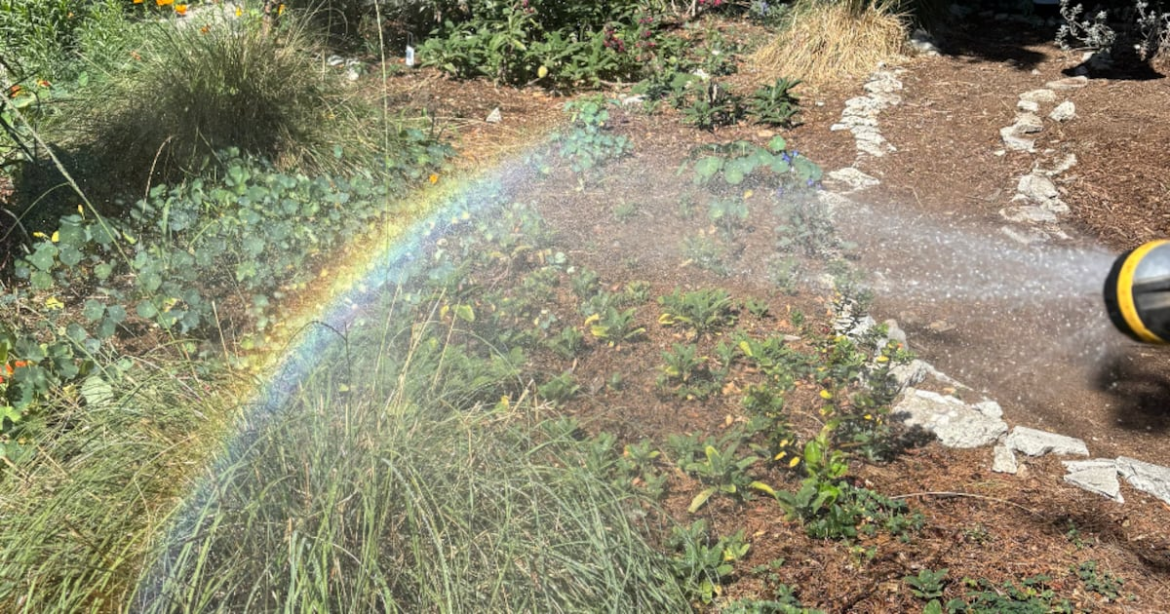Tucked away on Shrine Place, the USC Peace Garden is a quiet patch of grass nestled between sun-bleached concrete and tall apartment buildings. A brightly colored mural welcomes visitors in and a box of freshly picked lemongrass sits on the fence, inviting people who pass by to take some home.
You’d never guess by the tall tomato plants growing in the backyard or the stray cats who have made the garden their home that just three years ago, this was an empty lot.
With a grant from the Chan School of Occupational Therapy, professor Camille Dieterle turned the largely empty lot into a functioning garden in seven months, bringing in volunteers to clean up trash and weeds, install raised gardening beds and plant vegetables.
Occupational therapy doctoral student Flor Rodriguez says the mission of the garden is to “alleviate the whole food desert situation that’s going on here around this neighborhood.”
In addition to promoting community health and green space in urban settings, the garden also focuses on growing California native plants and increasing sustainability education.
Rodriguez helps lead one of the occupational therapy classes that relies on the Peace Garden, called OT-312: Creating a Sustainable Life.
“The class of OT-312 is learning through doing, so the more we get to do, and the more engaged the students are in doing, the more they are learning theoretically,” Rodriguez said.
One of those students is sophomore David Rendon. They meet with their Creating a Sustainable Life class every Monday to discuss different aspects of sustainability and tend to the Peace Garden.
“I picked a carrot today,” Rendon recalled. “I did not know that you could plant carrots in February and have ‘em be ready by April. I thought that took like a year. On the first day of class I took home a beet or a radish, That was yummy. I put in a salad.”
Rendon’s gardening skills, however, are a work in progress.
“I don’t think anything I’ve planted has survived so far. I have tried checking on everything,” Rendon said. “I’ve got some, like three sprigs of basil that are going all right. None of the sunflowers I’ve planted have survived. None of the peppers I’ve planted have survived.”
It’s not just Rendon’s plants struggling. This season, as spring turns to summer, the heat is climbing.
Doctoral student Diana Amaya-Chicas has noticed that the plants aren’t soaking up the water they need.
She stands by the raised beds, gripping a garden hose as she touches the plants’ wilting leaves.
“When it’s like hotter, I feel like it’s not enough, honestly,” Amaya-Chicas said. “Last year, we depended on just the drip line and some of the stuff dried out, so I’m trying to make sure we stay ahead of it this year.”
As an intern with the garden, it’s her job to keep the plants happy and healthy.
“You can get lost in the details of one task, and I think to me that’s a lot of fun,” Amaya-Chicas said. ”Just getting lost in a task, just helps me with my mind, like recharge and focus.”
But the garden is more than a plot of land. It’s a place for people to connect with each other and with the earth.
Amaya-Chicas regularly hosts events to welcome the South Central community into the peace garden.
“Interacting with people is always really fun, especially when I’ve come across like actual community members from around here, a bunch of like elder Latinos. I actually even started an elders gardening club where we just like meet up, talk,” Amaya-Chicas said.
The workshops are just one way the Peace Garden reaches beyond campus.
“I incorporate things that I’ve learned in my grad schooling, like applying lifestyle redesign or applying group facilitation methods and techniques into the workshops,” Amaya-Chicas said.
The space has regular events and classes where people can share stories and sustainability practices.
“I’m currently cooking a lot more vegetarian meals. I don’t know if that’s something I would’ve done before the class, per se. It’s been really lovely,” Rendon said. “I’ve got a succulent at home. I’m taking care of that succulent. It’s grown, it’s thriving.”
Amaya-Chicas envisions the Peace Garden blooming in the coming years, growing more produce and connecting with more community members.
On weekends, she harvests greens and herbs, placing them in jars at the garden’s front fence, free for anyone who needs them.
Amayas-Chicas and Rodriguez are candid about the garden being a work in progress. This season has been tough on the plants that need the most water, and they sometimes have too many kittens wandering around than they can find adoptive homes for.
But the tomato plants are ripe, and the California poppies are in bloom. And the Peace Garden’s roots are on their way to becoming something deeper: as Rodriguez sees it, a permanent fixture in the neighborhood’s landscape.
“Being a native from L.A. and seeing that these spaces do exist and that people are working towards making them better, makes me feel really good,” Rodriguez said. “You’re walking into this property that just kind of seems like a home, but it’s actually this like green oasis in the middle of the hood. So it’s freaking awesome.”
A green oasis that’s part of USC, available to students and neighbors alike.

